Chinese Fire Belly Newt
- March 19, 2024
- 0 comment
The Chinese Fire Belly Newt (Cynops orientalis) is a small yet captivating amphibian native to China. Renowned for its vivid, fiery underbelly, which ranges from bright orange to red, this species not only mesmerizes herpetology enthusiasts but also plays an essential role in the balance of its ecosystem. This article delves into the habitat, behavior, diet, reproduction, conservation status, and care in captivity of the Chinese Fire Belly Newt, providing a comprehensive understanding of this fascinating creature.
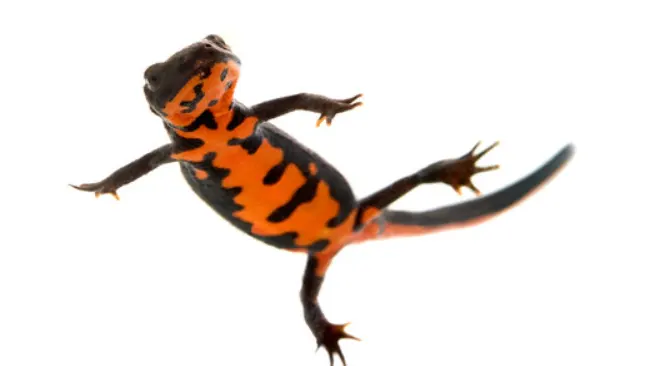
| Category | Details |
|---|---|
| Scientific Name | Cynops orientalis |
| Common Names | Chinese Fire Belly Newt |
| Classification | Kingdom: Animalia, Phylum: Chordata, Class: Amphibia, Order: Urodela, Family: Salamandridae |
| Size | Typically 6 to 10 centimeters in length |
| Weight | Varies with size, generally light due to small size |
| Lifespan | Generally 10 to 20 years in the wild, potentially longer in captivity |
| Habitat | Cool, freshwater habitats such as ponds, rice paddies, and slow-moving streams with abundant vegetation |
| Distribution | Native to China, particularly in provinces such as Zhejiang, Anhui, Jiangsu, and Fujian |
| Diet | Carnivorous, feeding on small invertebrates like worms, insect larvae, and small crustaceans |
| Behavior | Semi-aquatic, nocturnal, spending time both in water and on land. Exhibits aposematic coloration to warn predators of its toxicity. |
| Reproduction | Breeds in the spring with external fertilization. Females lay eggs individually on the underside of aquatic plants. |
| Conservation Status | Near Threatened, due to habitat destruction, pollution, and the pet trade |
| Conservation Efforts | Focus on habitat preservation, pollution control, and regulation of trade practices. |
| Cultural Significance | Appreciated in pet trade for its vibrant colors and as a subject of scientific interest for its unique adaptation and behavior. Its aposematic coloration serves as a natural model for studying predator-prey interactions and evolutionary biology. |
| Challenges | The main challenges include combating habitat destruction and pollution, managing the impacts of the pet trade, and adapting to climate change. Ensuring the survival of this species requires concerted conservation efforts and increased awareness of its ecological importance. |
Physical Characteristics
One of the most striking features of the Chinese Fire Belly Newt is its vibrant underside, which contrasts sharply with the darker, more subdued tones of its back and sides. This bright coloring is a form of aposematism, a biological term for the use of vivid coloration to warn predators of the toxicity that lies within. Adults typically reach lengths of 6 to 10 centimeters, with females generally larger than males.
Vibrant Underbelly
The Chinese Fire Belly Newt’s most captivating characteristic is its luminous orange to red underbelly, a vivid signal to deter predators by highlighting its toxic nature, effectively communicating a warning without the need for physical confrontation.
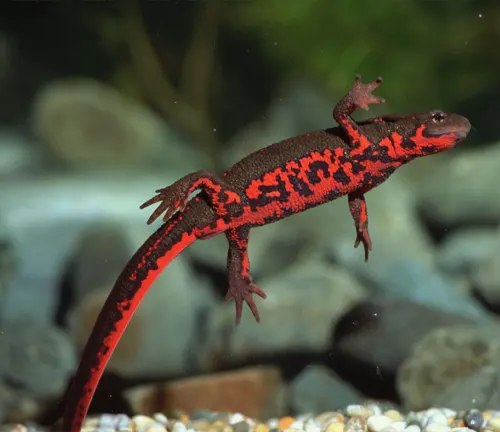

Dark Upper Body
The newt’s dark upper body, ranging from greenish-black to brown, seamlessly blends with the forest floor and aquatic plants, serving as perfect camouflage against predators and prey alike.
Large Eyes
The newt’s relatively large eyes are not just prominent features; they are highly adapted for superior vision in low-light conditions, enhancing its ability to navigate and hunt during nocturnal activities.
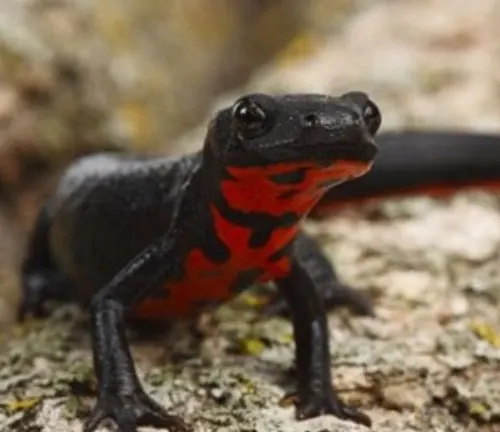

Webbed Feet
The Chinese Fire Belly Newt’s feet are uniquely webbed, a specialized adaptation that greatly enhances its swimming capabilities, allowing for efficient maneuvering through the water in search of food or evading predators in aquatic environments.
Laterally Compressed Tail
The newt boasts a long, laterally compressed tail, an evolutionary marvel that acts as a powerful aquatic rudder, enabling swift and agile propulsion through the water, optimizing efficiency in both hunting and evasion.
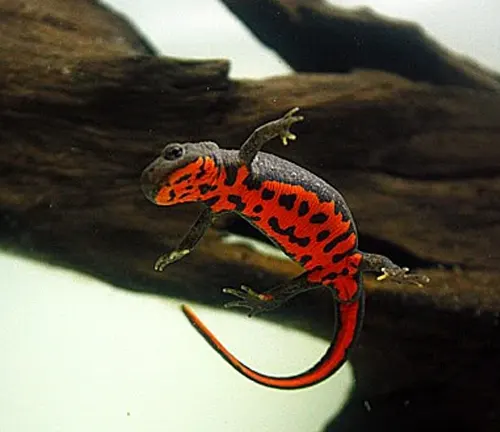
Habitat and Distribution
The Chinese Fire Belly Newt, a species distinguished by its vivid underbelly and adept aquatic abilities, primarily inhabits the serene, cool freshwater environments across several Chinese provinces such as Zhejiang, Anhui, Jiangsu, and Fujian. This amphibian finds solace in the tranquil waters of ponds, the structured wetlands of rice paddies, and the gentle flow of slow-moving streams, environments that are not only clean but also rich in vegetation.

Such habitats offer ample opportunities for hiding and hunting, playing a crucial role in the lifecycle of these newts. Furthermore, the temperate climate characteristic of these regions, marked by clearly defined wet and dry seasons, perfectly complements the breeding and feeding patterns of the Chinese Fire Belly Newt. This harmonious alignment between the newt’s biological needs and its natural surroundings underscores the delicate balance of aquatic ecosystems where these creatures thrive, highlighting the importance of preserving their habitats for the sustained survival of the species.
Behavior
Chinese Fire Belly Newts are semi-aquatic, spending time both in water and on land. They are nocturnal, preferring to hunt and explore during the night. During the day, they often hide under rocks or vegetation both in and out of the water. These newts are known for their hardiness and can live for more than 20 years in captivity with proper care.
Nocturnal Activities
These newts exhibit increased activity under the cover of darkness, utilizing the night hours to forage for food, thereby avoiding diurnal predators and the heat of the day.
Semi-aquatic Lifestyle
Adapted to both terrestrial and aquatic environments, Chinese Fire Belly Newts divide their time between water for feeding and breeding and land for resting and hibernation, showcasing their versatility.
Territorial Displays
During the breeding season, males may engage in elaborate displays to ward off rivals and attract mates, including body posturing, nudging, and leading females to suitable egg-laying sites.
Cautious Behavior
Exhibiting a strong survival instinct, these newts are quick to seek refuge at the slightest hint of danger, relying on their keen senses to detect threats.
Seasonal Breeding Patterns
Their reproductive activities are closely synchronized with environmental cues such as temperature changes and increased rainfall, indicating the onset of the spring breeding season.
Communication Methods
Though lacking vocal cords, Chinese Fire Belly Newts communicate through a combination of chemical signals, or pheromones, and physical gestures, particularly during mating rituals.
Predatory Tactics
Employing patience and precision, they wait for the opportune moment to ambush prey, using their quick reflexes and sticky tongue to capture and consume a variety of small aquatic invertebrates.
Social Behaviors
While generally solitary, they may tolerate the presence of conspecifics, especially in resource-abundant environments, indicating a degree of social flexibility.
Environmental Adaptability
Capable of thriving in a range of conditions, they nevertheless show a preference for cool, humid habitats that mimic their native environments, demonstrating their resilience.
Defensive Mechanisms
When threatened, in addition to secreting toxins, they may also adopt a defensive posture, arching their back to expose their brightly colored belly, which acts as a warning signal to potential predators about their poisonous nature.
Diet
In the wild, their diet consists mainly of small invertebrates, including worms, insect larvae, and small crustaceans. In captivity, they can be fed a variety of foods, such as frozen or live bloodworms, brine shrimp, and daphnia, ensuring they receive the necessary nutrients for their health and longevity.
Reproduction
The reproductive cycle of the Chinese Fire Belly Newt is intricately tied to the rhythms of nature, with the onset of spring marked by increased rainfall and a rise in temperatures, serving as the cue for the commencement of their breeding season. During this period, males engage in elaborate courtship rituals, which include gentle nudging and guiding of potential mates toward suitable egg-laying sites, an effort to ensure the success of their external fertilization.

Females, in turn, carefully deposit their eggs one by one on the undersides of aquatic plants, a strategic choice that camouflages their future offspring from the prying eyes of predators. This meticulous process ensures that the eggs remain protected in their aquatic nursery, allowing the newt’s lifecycle to continue with minimal interference from external threats, until the eggs hatch and the cycle begins anew.
Conservation Status
The Chinese Fire Belly Newt is currently listed as Near Threatened by the International Union for Conservation of Nature (IUCN). Habitat destruction, pollution, and the pet trade pose significant threats to their populations. Conservation efforts are crucial to ensure the survival of this species, focusing on habitat preservation, pollution control, and regulation of trade practices.
Care in Captivity
For enthusiasts looking to keep Chinese Fire Belly Newts as pets, it is essential to replicate their natural habitat as closely as possible. This includes providing a clean, well-filtered aquatic environment with plenty of hiding spots and a land area for basking. The water temperature should be kept cool, between 16-21°C (60-70°F), to mimic their natural temperate conditions. Regular water changes and a balanced diet are also crucial to their health.
Different Species
Japanese Fire Belly Newt (Cynops pyrrhogaster)
Larger than Cynops orientalis, this species is native to Japan and is known for its bright orange-red belly and a preference for cooler water.
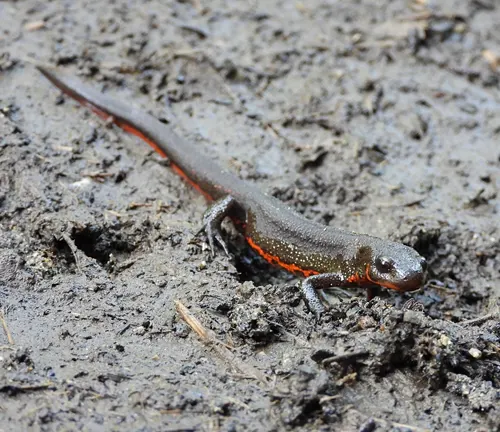
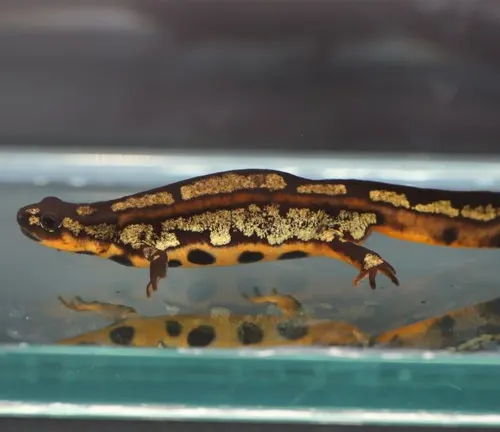
Sword-tail Newt (Cynops ensicauda)
Endemic to Japan, specifically the Ryukyu Islands, this species is distinguished by its longer tail and slightly different coloration patterns.
Paddle-tail Newt (Pachytriton labiatus)
While not a true fire belly newt, this species is often found in the pet trade and mistaken for one. It is larger and has a more robust body, with a preference for colder water.
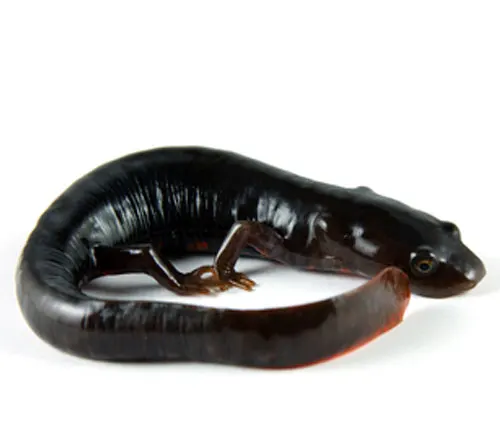
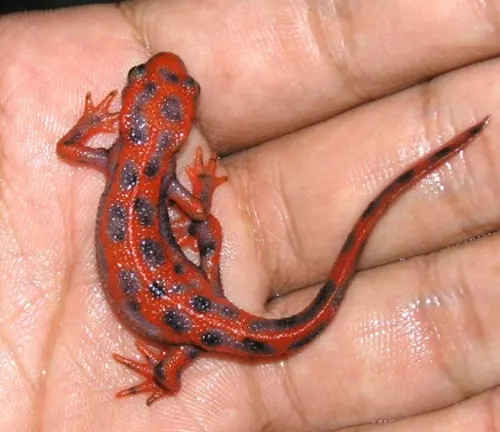
Yunnan Lake Newt (Cynops wolterstorffi)
A rare species endemic to China, specifically Yunnan Province, characterized by its unique habitat preferences and distinct coloration.
Anderson’s Crocodile Newt (Echinotriton andersoni)
Also known as the Anderson’s Salamander, this species is found in Japan and the Ryukyu Islands, notable for its rough, crocodile-like skin and distinct behavior.

Conclusion
The Chinese Fire Belly Newt is not only a species of great aesthetic appeal but also an indicator of environmental health in its native habitats. Through understanding and respecting their needs, both in the wild and in captivity, we can ensure the continued survival of these remarkable amphibians for generations to come.
Frequently Asked Questions (FAQs)
- What is the scientific name of the Chinese Fire Belly Newt?
The scientific name of the Chinese Fire Belly Newt is Cynops orientalis, and it belongs to the family Salamandridae. - Why is the belly of the Chinese Fire Belly Newt so brightly colored?
The bright orange to red belly of the Chinese Fire Belly Newt serves as a form of aposematism, a biological term for coloration used to warn predators of the organism’s toxicity, effectively deterring potential threats. - Where can Chinese Fire Belly Newts be found in the wild?
Chinese Fire Belly Newts are endemic to China, particularly in provinces such as Zhejiang, Anhui, Jiangsu, and Fujian, where they inhabit clean, freshwater environments like ponds, slow-moving streams, and rice paddies. - What do Chinese Fire Belly Newts eat?
In their natural habitat, Chinese Fire Belly Newts primarily feed on a diet of small invertebrates, including various types of worms, insect larvae, and small crustaceans, showcasing their carnivorous nature. - How long do Chinese Fire Belly Newts live?
These newts have a relatively long lifespan, capable of living up to 20 years in captivity with proper care, while their wild counterparts tend to have slightly shorter lifespans due to natural predation and environmental challenges. - Are Chinese Fire Belly Newts good pets?
Chinese Fire Belly Newts can make fascinating pets for enthusiasts willing to replicate their natural aquatic and terrestrial environments, provide a diet rich in small invertebrates, and understand their need for minimal handling due to the potential risks posed by their skin toxins. - What are the main threats to the Chinese Fire Belly Newt?
The survival of the Chinese Fire Belly Newt is jeopardized by several factors, including habitat destruction due to urbanization and agriculture, pollution from pesticides and industrial waste, and overcollection for the pet trade, necessitating conservation efforts. - How do Chinese Fire Belly Newts reproduce?
Reproduction occurs in the spring, with a unique courtship display by males, followed by external fertilization of eggs laid individually by females on aquatic vegetation, emphasizing their reproductive strategy adapted to aquatic environments. - Is the Chinese Fire Belly Newt considered endangered?
Classified as Near Threatened, the Chinese Fire Belly Newt faces significant environmental challenges, but not yet at the critical level of being endangered, highlighting the need for ongoing conservation efforts to prevent further decline. - Can you touch a Chinese Fire Belly Newt?
While it is possible to gently handle Chinese Fire Belly Newts on rare occasions, it is highly recommended to do so with caution and clean hands to avoid the transfer of toxins and to protect the newt’s delicate skin, underscoring the importance of responsible pet ownership.

Jack Williams
Forestry AuthorI'm Jack Williams, Jack Williams, my expertise in welding and generator technologies extends beyond traditional boundaries. With over 13 years of experience, I have honed my skills in a range of heavy-duty equipment, focusing particularly on welding and power generation. My passion for nature and commitment to ecological sustainability inform my approach to work. I emphasize safety, efficiency, and staying current with technological advancements. Beyond my technical skills, I am dedicated to sharing knowledge and fostering environmental awareness, aiming to contribute positively to both the welding and generator operation industries.





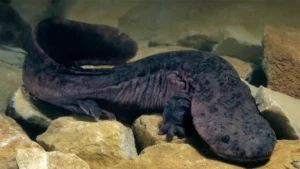
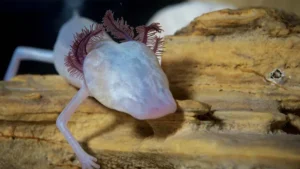
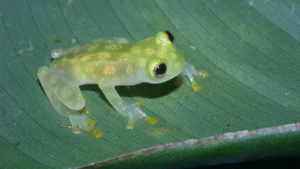


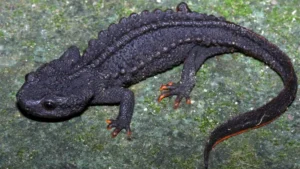


Leave your comment